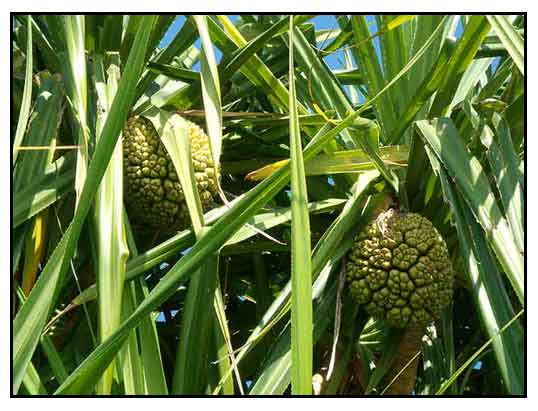 General info General info
Pandanus is a genus of monocots of about 600 known species, varying in size from small shrubs less than a meter to medium-sized trees of about 20 meters.
In the Philippines there are 48 species of Pandanus, many of them are endemic, growing in various habitats, from sandy beaches, mangroves and primary forests. The fruit of somes species are edible, eaten by bats, rats, crabs, elephants and lizards. The majority of species are disperesed primarily by water.
Botany
Pandan-mabango is a much-branched shrub or small tree, up to 6 m high, with numerous branchlike stilt roots. Leaves are leathery, stiff, becoming pendant and crowded at the apex, swordlike, keeled, the marings and keel are lined with sharp, stiff spines. Male spadices are about 10 cm long and fragrant. Female inflorescence is globose, up to 5 cm diameter. Fruit is an oblong or globose syncarp, to 25 cm across.
Note: Quisumbing's botanical description for pandan mabango - that of a small plant that does not grow over a meter, not known to flower or fruit in the Philippines - probably refers to Pandanus amaryllifolius (syn. Pandanus odorus) rather than P. odoratissimus. (G. Stuart)
Distribution
Introduced in the Philippines.
Common along sandy beaches.
Now, cultivated as an ornamental.
Also occurs in India, Persia, and Arabia; and cultivared in Malaya.
Constituents
Contains an essential
oil, bitter and aromatic.
Perfumed oil, called Kevda oil, is extracted from floral bracts.
Phytochemical study yielded phenols, tannins, terpenes, alkaloids and flavanoids.
Study of essential oil showed the major components to be: 2-phenyl ethyl methyl ether (37.7%), terpinen-4-ol (18.6%), α-terpineol (8.3%) and 2-phenyl ethyl alcohol (7.5%).
Root parts have yielded two phenolic compounds, four lignan type compounds and a benzofuran derivative.
Properties
Oil is considered a stimulant, antispasmodic and antiseptic.
Roots are diuretic, tonic and depurative.
Considered cardiotonic, cephalic and aphrodisiac.
Parts used
Leaves
Uses
Others
- In the Philippines, leaves
are popularly used in the cooking of rice, imparting a pleasant fragrance
and flavor.
-
Leaves are also used to flavor ice cream and sherbets.
Folkloric
Powder made from interior
of anthers, smoked for sore throat.
Root, brayed in milk, used internally for sterility and threatened abortion.
Used for small pox and leprosy.
Ashes of wood used for wound healing.
Seed concotions used to strengthen the heart and liver.
Oil used as stimulant and antispasmodic; used for headaches and rheumatism.
In India, oil is used as remedy for earache and meatal suppuration.
In northern India, used for jaundice.
Powder made from anthers and tops of bracts used for epilepsy.
Others
• Perfumery / Cosmeticfs: Oil is valued as perfumery and cosmetic ingredient.
Studies
• Antioxidant:
Study of methanol and aqueous extracts of P. odoratissimus roots showed higher antioxidant potential in the DPPH scavenging assay and reducing capacity. A positive correlation was found between phenolic and flavonoid content.
•Hepatocurative:
Study of Ketaki (P. odoratissimus) root decoction on carbon tetrachloride-induced liver damage in albino rats showed it to be hepatocurative but not hepatoprotective.
• Antibacterial:
Study showed a broad spectrum of antibacterial activity and a potential source for new classes of antibiotics.
• Free Radical Scavenging Activity:
Study of the methanolic effect of P. odoratissimus against free radical damage showed 87.52% reduction of DPPH and 73.55% inhibition of nitric acid.
Availability
Wildcrafted.
Small scale commercial production.
|

![]()



 General info
General info